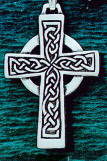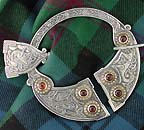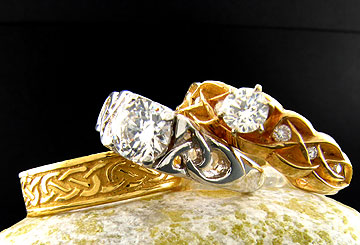|
In Search of Meaning: Symbolism of Celtic Knotwork (part 4) Copyright Stephen
Walker Note: This article
was published in Dalriada Magazine, Bride 2001 issue. Due to a blunder on the
part of the author, the published version was not the correct final product.
Below is the intended final draft. Often the first question asked about
Celtic interlace is �What does it mean?�
The assumption is that these designs are a secret language of symbols
that could be decoded if we only had the key.
The
case of the triquetra or three-fold knot is a good example of the
difficulty that one faces when trying to assign specific meaning to Celtic
designs. Sacred numbers and the
symbolism of numerology offer a promising basis for the interpretation of Early
Christian Celtic ornament. The
triquetra is an obvious sign of the Holy Trinity. Other knots could represent
the four directions, the twelve Apostles and so on.
But as important as numbers are in Scripture, legends and poetry, the
connection remains elusive and evidence circumstantial. J.
Romilly Allen writing in Early Christian Monuments of Scotland (1903)
says: With
the exception of the instances at Meigle and at Llanfrynach, in Brecknockshire,
the triquetra is used for purely ornamental purposes, and there is not the least
foundation for the theory that it is symbolic of the Holy Trinity. If the
triquetra knot had ever any symbolical significance at all it was probably in
pagan times and in that case it probably had some affinity with the
triskele...� He goes on to say
how well suited the triquetra is to filling any triangular space.
Allen�s premise seems to be based on the observation that the triquetra
(and other interlace designs) play a decorative role and are not given the
prominence of placement that that one would assume an important symbol should
have. The Meigle stone being an exception because the triquetra is arranged
among other Pictish symbols in a way that it is definitely not a space filler,
so possibly used as a symbol in this case. Fran�oise
Henry in Irish Art in the Early Christian Period (1940) writes about a
stone slab at Killagtee, Donegal. A rather primative monument with an equal
armed cross in a circle at the top and the only other carving is a large
triquetra that is curiously off to one side. She states: �This knot stands
most probably for the Trinity, and the whole cross seems to be an awkward
version of the Chi-Rho..." Allen
opines that the triquetra is not a Trinity symbol and casts doubt that it was
used as a symbol at all. Henry suggests that it probably stood for the
Trinity, at least in this one case, but leaves the question open. Each of these
experts were leading authorities in their day and neither gives a definite
answer to the question of meaning for the knot that should be the easiest to
explain. When the triquetra stands alone it certainly looks like a symbol, but in early Christian Celtic venues it rarely does. If the triquetra had formerly been used as it is now, we would have no reason to doubt its function as a symbol. In modern times it has been customary to display designs alone that would have been details in older work. These stand-alone details are frequently seen in books about Celtic Art or on modern day Celtic craft objects. When a single knot appears alone, as say a pendant that is a single triquetra, it seems as if it must be a symbol. Given the Celt�s penchant for blessings and invoking the Holy Trinity, the meaning of the triquetra seems more obvious than any other knotwork. The triquetra is quite commonly called the �Trinity knot� and has been consciously used as a Christian symbol during the 150 years of the Celtic Revival. In recent decades it has also been appropriated as an emblem of the �Triple Goddess� by Pagan revivalists. When someone plucked the triquetra out of antiquity and it stood alone in modern times, this was a creative act and the triquetra was no longer just a pretty space filler. Celtic
interlace, or attempts at something that looked like it have been made in every
century since the Insular style first emerged in the 7th century.
At first interlace was being used to decorate Gospels and symbols of
Christian faith such as crosses. Religious
and secular use of Celtic Art cannot be seen as expressing any national identity
prior to the Norman invasion, especially when it is recognized that at this time
several peoples, the Irish, the Picts, the Scots of Dal Riada and the
Northumbrians all had artists that excelled in the style. The nearest neighbors,
the southern Anglo-Saxons, the Welsh and many continental religious communities
also produced manuscript decorations in the Celtic or �Hiberno-Saxon�
tradition. During the
�Golden Age� of Celtic art, 7th to 10th centuries, the
style and vocabulary of ornament was an international style throughout
the region. With
the Norman invasions of Britain and Ireland, Celtic design went into decline.
Traditions of using interlace designs lingered in some of the more Gaelic
areas. It eventually became a way of identifying with the older Gaelic cultural
tradition in the face of advancing Anglo-Norman power. In the Hebrides and West
Highlands, the Lords of the Isles and other Gaelic aristocrats continued to
patronize the carving of interlace decorated monuments as well as portable
objects. By the 15th century there was a self-conscious preservation
of an older social order with a distinctly Celtic heritage. Knotwork became to a
certain extent an emblem of political and cultural identity. Rustic and
sometimes very crude attempts at carving knotwork on grave monuments speak of
the desire of impoverished but proud Highlanders to imitate the glory of their
ancestors. Weapons and jewellery
associated with the Jacobite movement continued to be decorated with knotwork
until 1745. At this point the longest gap appears in the continuity of use.
Little, if any knotwork was produced from then until the dawn of the Celtic
Revival in the mid-1800�s. The
Celtic Revival in Ireland began as an effort to restore a sense of pride in a
distinct Irish culture. For the most part this was a literary movement but a
rediscovery of artistic treasures of the distant past were being introduced to
the public imagination as well. Objects such as the Book of Kells and the Tara
Brooch were concrete evidence that the Irish had once been a sophisticated,
civilized society, not merely the degenerate barbarians as the English overlords
often regarded them. The re-use of Celtic designs began as imitations of
historical jewellery and monuments that were used as an affirmation of Irish
identity and an association with the glory of past times. By the 1890�s Celtic
design was taken up by the Irish branches of the Arts and Crafts Movement and a
more contemporary interpretation emerged as well as the establishment of cottage
industry enterprises making Celtic crafts. During
the same time in Scotland, Queen Victoria was an enthusiastic promoter of a
romantic vision of Scottish national identity.
Celtic design we might logically imagine as part of the pomp and regalia
of 19th century Scottish national image, but it was slow to catch on
in Scotland. Dirk handles had been one of the last places that knotwork had been
carved before it all but disappeared after the failed 1745 uprising. Victorian
dirks were carved with thistles and clan or regimental emblems, rather than the
traditional interlace. It was later
in the 19th century that knotwork began to add ornaments to tartan.
The trend towards Celtic design on Highland dress accessories have slowly but
steadily increased to the present. The
earliest Celtic Revival monuments are from the 1860�s.
In both Scotland and Ireland monumental carving was and remains the most
conspicuous uses of Celtic design. Many
of the most elaborate earlier monuments of the Celtic Revival are the
gravestones of priests. Recognition of the legacy of the Celtic Church was being
expressed with the creation of new �High Crosses� both as public monuments
and as grave markers. Sometimes
the revival got the designs right, in terms of historical rules of design but
often what was made was a poor substitute. Cross hatching sometimes fills in as
a sort of short hand for knotwork and frequently the conventions of over-under
alternation and layout traditions are completely lacking. Whatever message there
may be hidden in knotwork when it is done in an authentically traditional way,
the message frequently is that the style itself, or a clumsy imitation of that
style, is an emblem of Celtic heritage. A
standard answer to the meaning of knotwork question offered by many craftsmen
and artists in recent times is that Celtic knots are endless paths and so
represent eternity or continuum. The Scottish art teacher George Bain published
the book Celtic Art; The Methods of Construction in 1951. This book
became a standard reference and source book especially after its re-release in
1971. In it the author made a great
deal of the single continuous path that is laid out in many ancient knotwork
panels. This observation leads
quite nicely to ideas about the �circle of life� or �never ending� love,
faith, loyalty, what ever you want.� Many
ancient Celtic knots are not a single path, but several closed paths that are
linked or woven together. These can be seen as metaphors for the interwoven-ness
of life, or linking knots are frequently referred to as �love knots.� To
some these seem like trite, pat answers to the question of meaning, which may
have more to do with marketing than with any authentic tradition. But who can
tell? Why would it be that continuum would
be such an important concept that an elaborate symbology as knotwork would be
contrived? In modern times those
who maintain an interest in Celtic things, be it Celtic music, dance, religion,
folklore or history, may relate to the idea of continuum in their desire to
affirm and preserve a culture they value, nobly surviving despite centuries on
the margins of European mainstream. Among
Celtic Diaspora, those
emigrants and their descendants whose interest in their roots have become a
passion are especially likely to relate to a message of continuum as they strive
to maintain an identity with their heritage in the multi-cultural melting pot of
the New World. If the modern motive
for creating or viewing Celtic knotwork involves a sense of heritage, the
message of continuum seems to work. The �secret language� mystique of Celtic art is what makes it so very fascinating to many who look to it today for significance. Many myths carry a lesson about truth. The myth that every miniscule detail of Celtic art is symbolic, like all genuine folklore, has many variations. The various beliefs that the symbolism is now lost or perhaps dimly remembered or optimistically preserved by a few who have kept and studied the old traditions, cloaks Celtic art in an exciting veil of mystery.
|



